Overview
IFRS 3 Business Combinations – is largely about how the initial accounting for a new investment, setting out the rules on the calculation of goodwill. These IFRS 3 summary notes are prepared by mindmaplab team and covering, IFRS 3 revised amendment, the key definitions, full standard with illustrative examples, IFRS 3 goodwill, negative goodwill IFRS, contingent consideration, purchase price allocation (ppa), step acquisition, IAS 3 consolidated financial statements, IFRS 3 intangible assets, difference between IFRS 3 and IFRS 10, goodwill impairment with IFRS 3 disclosure requirements. This is the IFRS 3 full text guide; we have also prepared IFRS 3 pdf version download.
IAS Standards
IAS 2 Inventories
IAS 7 Statements of cash flows
IAS 7 Statement of cash flows – Revisited
IAS 8 Accounting policies, changes in accounting estimates, and errors
IAS 10 Events after the reporting period
IAS 16 Property, plant and equipment
IAS 20 Accounting for government grants and disclosure of government assistance
IAS 21 The effects of changes in foreign exchange rates
IAS 24 Related party disclosures
IAS 27 Consolidated and separate financial statements
IAS 28 Investments in associates and joint ventures
IAS 32 Financial instruments: presentation
IAS 33 Earnings per share – Revisited
IAS 37 Provisions, contingent liabilities and contingent assets
IFRS Standards
IFRS 5 Non-current assets held for sale and discontinued operations
IFRS 7 Financial instruments: disclosures
IFRS 10 Consolidated financial statements
IFRS 12 Disclosure of interests in other entities
IFRS 13 Fair value measurement
IFRS 15 Revenues from contracts with customers
IAS 17 VS IFRS 16 Lease – Differences
International accounting standards and group accounts
The following standards relate to accounting for investments:
- IFRS 3 Business combinations
- IFRS 10 Consolidated financial statements
- IFRS 11 Joint Arrangements
- IAS 27 Separate financial statements
- IAS 28 Investments in associates and joint ventures
Guidance on the process of consolidation is set out in two standards, IFRS 3 Business Combinations and IFRS 10 Consolidated Financial Statements.
Introduction to IFRS 3
It establishes principles and requirements for:
- the recognition and measurement of identifiable assets acquired, liabilities assumed and non-controlling interest in the acquiree;
- IFRS 3 is largely about how the initial accounting for a new investment, setting out the rules on the calculation of goodwill.
- IFRS 3 explains how to account for further investments in a subsidiary after control has been achieved. These are called step acquisitions.
- disclosures that enable users to evaluate the nature and financial effects of a business combination.
IFRS 3 Definitions
Business combination – A transaction or other event in which an acquirer obtains control of one or more businesses.
Acquisition date – is the date on which the acquirer effectively obtains control of the acquiree.
Goodwill – An asset representing the future economic benefits arising from other assets acquired in a business combination that are not individually identified and separately recognised.
Goodwill
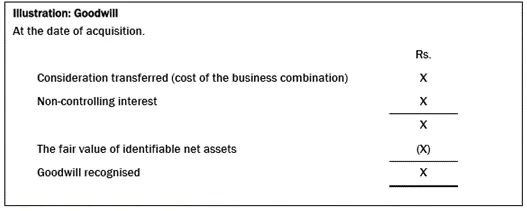
IFRS 3 gives guidance on:
- cost of a business combination;
- recognition and measurement of identifiable assets and liabilities assumed; and
- accounting for goodwill.
Cost (consideration transferred)
IFRS 3 states that the purchase consideration for an acquisition (business combination) is the sum of:
- the fair values, at the acquisition date, of the assets transferred by the acquirer, such as cash
- the liabilities incurred by the acquirer to the former owners of the acquire
- equity instruments issued by the acquirer in exchange for control of the acquiree.
* The purchase consideration may include some deferred consideration.
Consideration includes any asset or liability resulting from a contingent consideration arrangement:
- recognised at acquisition-date fair value; and
- classified as a liability or equity on the basis of guidance in IAS 32 or other applicable IFRSs.
Acquisition-related (transaction) costs are costs the acquirer incurs to effect a business combination. For example, the cost of the advisory, legal. These costs must be treated as an expense as incurred and written off to profit or loss.
Contingent consideration
Sometimes the final cost of the combination is contingent on (depends on) a future event. In a situation such as this, the contingent payment should be included in the cost of the combination (discounted to present value if the payment will occur more than 12 months in the future).
* Under the rules of IFRS 3, contingent consideration must be recognised at fair value at acquisition, even if it is not probable that the consideration will actually have to be paid.
If the contingent consideration is still there at the end of an accounting period, it might be necessary to re-measure it. If the contingent consideration will be payable in cash or take the form of debt it should be re-measured to fair value at the end of the reporting period. Any gain or loss on re-measurement should be taken to profit or loss.
If the contingent consideration will take the form of equity, it is not re-measured at the end of the reporting period.
* IFRS 3 states that the award of share options to the previous owners as an incentive to stay on and work for the subsidiary after it has been acquired is not a part of the purchase consideration.
Acquisition date amounts of assets acquired and liabilities assumed
An acquirer of a business must recognise assets acquired and liabilities assumed at their acquisition date fair values. To support this IFRS 3 sets out:
- a recognition principle;
- classification guidance; with
- a measurement principle.
Recognition principle
An acquirer must recognise (separately from goodwill), identifiable assets acquired, liabilities assumed and any non-controlling interest in the acquiree as of the acquisition date.
This might result in recognition of assets and liabilities not previously recognised by the acquiree.
The contingent liabilities should be measured at fair value at the acquisition date (even if it is not probable). Contingent assets are not recognised.
An acquirer should not recognise a liability for the cost of restructuring a subsidiary or for any other costs expected to be incurred as a result of the acquisition (including future losses).
Measurement principle
Identifiable assets acquired and the liabilities assumed are measured at their acquisition date fair values.
Deferred income tax assets and liabilities are recognised and measured in accordance with IAS 12 Income Taxes, rather than at their acquisition-date fair values.
Classification guidance
Identifiable assets acquired and liabilities assumed must be classified (designated) as necessary at the acquisition date so as to allow subsequent application of appropriate IFRS.
- classification of a lease contract in accordance with IFRS 16 Leases; and
- classification of a contract as an insurance contract in accordance with IFRS 4 Insurance Contracts.
Accounting for Goodwill
After initial recognition goodwill is measured at cost less any accumulated impairment losses. It is not amortised.
Gain from a bargain purchase (“Negative goodwill”)
A bargain purchase is a business combination in which the calculation of goodwill leads to a negative figure. Such amount is recognised as a gain in consolidated profit or loss on the acquisition date.
Impairment testing of goodwill
Purchased goodwill is not amortised, but must be tested for impairment on an annual basis. It cannot be tested for impairment directly. It is allocated to one or more cash generating unit (IAS 36).
Partial goodwill method (NCI at acquisition measured as a proportionate share of subsidiary’s net assets)
The carrying amount of the CGU is made up of:
- the total net assets of the unit (parent’s interest and NCI’s); and
- the parent’s interest in goodwill.
The goodwill included in the CGU, as stated above, represents the parent’s share only, but the cash flow contributed by goodwill does not pertain to parent share of goodwill only. It also includes contribution made by NCI share of goodwill. Therefore, IAS 36 requires a working that grosses up the carrying amount of the CGU’s assets by the NCI share of goodwill.
*Note that NCI share of goodwill is only for a working purpose, it is not part of the double entry.
This notionally adjusted carrying amount is then compared with the recoverable amount of the unit to determine whether the cash-generating unit is impaired.
*Only that part of any impairment loss attributable to the parent is recognised by the entity as a goodwill impairment loss.
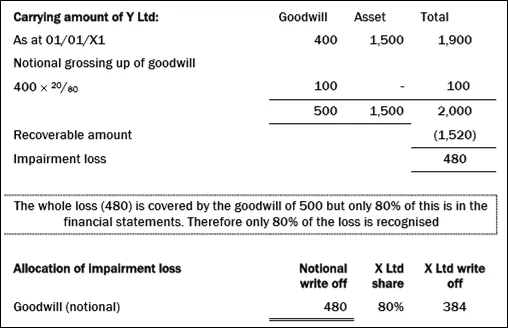
Full goodwill method (NCI at acquisition measured at fair value)
When non-controlling interests are valued by the fair value method, any impairment in the total goodwill after acquisition should be shared between the parent company shareholders and the NCI.
If there is an NCI in a cash-generating unit to which goodwill has been allocated, the carrying amount of that unit is made up of:
- both the parent’s interest and the NCI in the net assets of the unit; and
- both the parent’s interest in goodwill and the NCI’s interest in goodwill.
Acquisitions achieved in stages
Control might be achieved through a series of transactions. (These are known as step acquisitions, successive share purchases or piecemeal acquisitions).
Consolidation is from the acquisition date which is the date that control is achieved.
IFRS 3 requires that, for a business combination achieved in stages, the parent must remeasure any previously held equity interest in the new subsidiary to its fair value at the date that control is achieved. This is added to the cost of the investment that resulted in control.
The gain or loss on the remeasurement of the previously held equity interest is recognised in profit or loss or other comprehensive income.
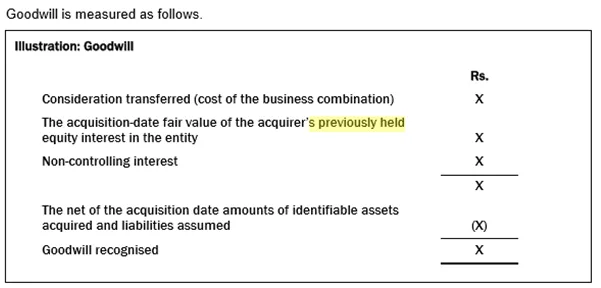
Purchase of additional equity interest after control is achieved
A company may make a further purchase of shares after control has been achieved.
This is a transaction between the owners of the subsidiary (the controlling interest and the non-controlling interest) which will cause the non-controlling interest to change.
Any difference between the purchase consideration and the change in the non-controlling interest is recognised directly in equity.

*The reduction in non-controlling interest at the date of the purchase is the share of net assets given up by the non-controlling interest at that date.
Non-controlling interest (NCI)
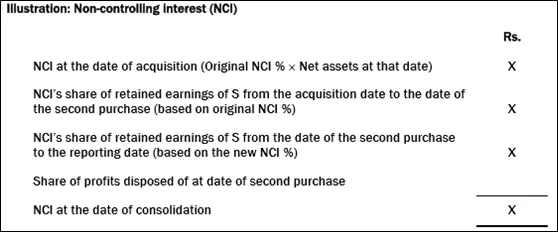
Consolidated retained earnings
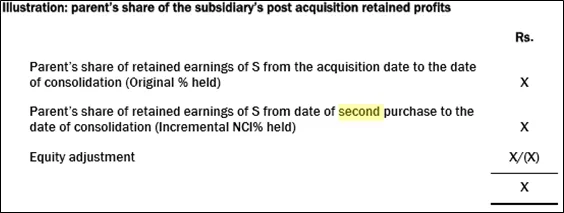
Accounting Summary: Pattern of ownership in the consolidated statement of profit or loss
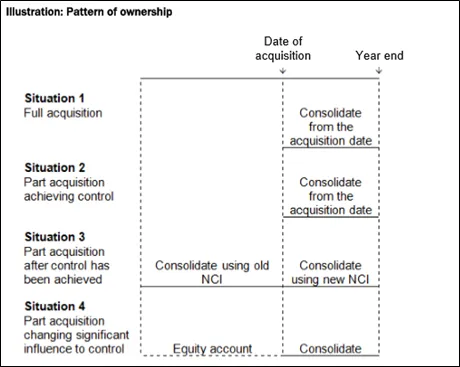
Situation 4: Purchase turning significant influence into control
In this case the parent had significant influence in the first part of the years and then made an acquisition which achieved control. The results for the year must be split into two parts. The results for the period in which the parent had significant influence must be equity accounted. The results for the period in which the parent had control must be consolidated.
Consolidated statement of profit or loss
The basic rules
A consolidated statement of profit or loss brings together the sales revenue, income and expenses of the parent and the sales revenue, income and expenses of its subsidiaries.
Inter-company items
It is usually necessary to make adjustments to eliminate the results of inter-company trading. This includes adjustments to cancel out inter-company trading balances and unrealised profit.
Inter-company trading
Inter-company trading will be included in revenue of one group company and purchases of another. These are cancelled on consolidation.
Unrealised profits on trading
If any items sold by one group company to another are included in inventory (i.e. have not been sold on outside the group by the year end), their value must be adjusted to lower of cost and net realisable value from the group viewpoint (as for the consolidated statement of financial position).
The adjustment in the statement of comprehensive income reduces gross profit and hence profit for the year. The NCI share in this reduced figure and the balance is added to retained earnings. Thus, the adjustment is shared between both ownership interests.
Inter-company management fees and interest
All other inter-company amounts must also be cancelled.
Inter-company dividends
The parent may have accounted for dividend income from a subsidiary. This is cancelled on consolidation.
Dividends received from a subsidiary are ignored in the consolidation of the statement of comprehensive income because the profit out of which they are paid has already been consolidated.
Accounting for Impairment of goodwill
If goodwill is impaired:
- It is written down in value in the consolidated statement of financial position, and
- The amount of the write-down is charged as an expense in the consolidated income statement (normally in administrative expenses).
Consolidated statement of other comprehensive income
The basic rules
A consolidated statement of other comprehensive income brings together the gains and losses of the parent and the gains and losses of its subsidiaries.
Items in the statement of comprehensive income are unlikely to be affected by inter-company trading or similar issues.
Consolidated financial statements must disclose total comprehensive income for the period attributable to the:
- owners of the parent company; and
- non-controlling interests.

Consolidation of sub-subsidiaries (two stage method)
Vertical groups
A group structure in which a parent has a subsidiary which in turn is itself a parent of another subsidiary is known as a vertical group. It follows that a parent will also control its subsidiary’s subsidiary.
Date of acquisition of the sub-subsidiary
A subsidiary must be consolidated from the date of acquisition. The acquisition date for a sub-subsidiary in a vertical group depends on whether:
- the holding company H acquired its shares in subsidiary S before S acquired its shares in the sub-subsidiary T; or
- the holding company H acquired its shares in subsidiary S after S acquired its shares in the sub-subsidiary T
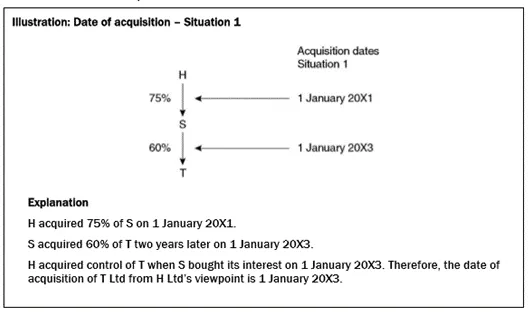
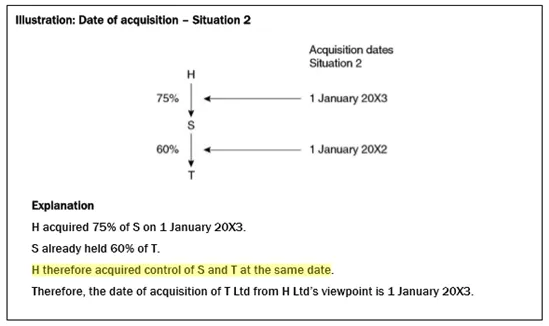
*There are two methods (direct and indirect) which can be used for dealing with sub-subsidiaries. The different methods may result in different balances for certain items.
Indirect method (2 stages)
The consolidation takes place in two stages. Firstly, the S group accounts are prepared by consolidating T into S. Then, the S group accounts are consolidated into H.
The indirect method is the way that most groups would perform consolidation in practice.
Direct method (1 stage)
This approach involves identifying holding company H’s effective holding in the sub-subsidiary and then using this to consolidate the sub-subsidiary directly along with the main subsidiary.
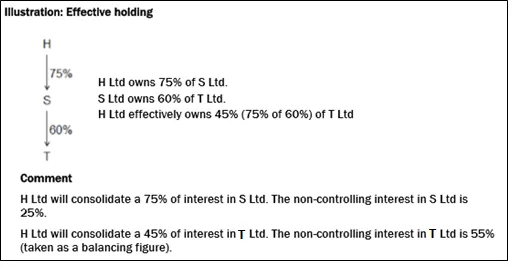
The main subsidiary is consolidated by the parent in the usual way.
The sub-subsidiary is also consolidated by the parent in the usual way using the effective holding with one further adjustment. The cost of investment in T is split. H’s share is used in the goodwill working and the balance is charged to the non-controlling interest.
Rationale for splitting the cost of investment when using the direct method
Goodwill
The effective interest is the parent’s share of the main subsidiaries share of the sub-subsidiary.
- Goodwill calculated for the main subsidiary is cost less share of net assets.
- Goodwill calculated for the sub-subsidiary must be the share of cost less share of share of net assets.
Non-controlling interest
Consolidation involves replacing cost of investment with a share of net assets. Using the effective interest to calculate the NCI in the sub-subsidiary gives the NCI in the main subsidiary a share of the net assets of the sub-subsidiary. However, the NCI in the main subsidiary has already been given a share of the net assets of the main subsidiary and this includes the cost of investment in T. Therefore, the NCI in the main subsidiary’s share of cost must be eliminated to avoid double counting.
Mixed groups
In a mixed group, the parent has both direct and indirect interests in the sub-subsidiary.
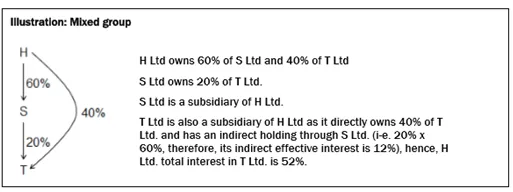
Date of acquisition of the sub-subsidiary in a mixed group
The same rules apply to mixed groups as they do to vertical groups.
If H’s direct and indirect interests in the sub-subsidiary arise on different dates the step acquisition rules apply.
*Direct method consolidation of is used for mixed group
Accounting for sub-associates
There is no such choice in accounting for interests in sub-associates. They must be accounted for using a two-stage approach.
- Step 1: The investment is equity accounted into the financial statements of the main subsidiary.
- Step 2: The revised statements of the main subsidiary are then consolidated with those of the parent. The main subsidiary’s non-controlling interest will share in the equity accounted associate in the usual way.
There is no concept of effective holding when accounting for investments in sub-associates.
Consolidated statements of profit or loss when there are sub-subsidiaries
Consolidation of statements of profit or loss involving sub-subsidiaries and sub-associates is carried out as normal. The effective rate may be used to consolidated sub-subsidiaries and sub-associates are equity accounted using a two-stage process.
There is one possible complication when consolidating sub-subsidiaries.
- If the sub-subsidiary has paid a dividend and the main subsidiary has accounted for its share through the profit and loss account this will be part of the subsidiary’s profit before tax.
- It must be eliminated (as a consolidation adjustment) during the non-controlling interest calculation.
